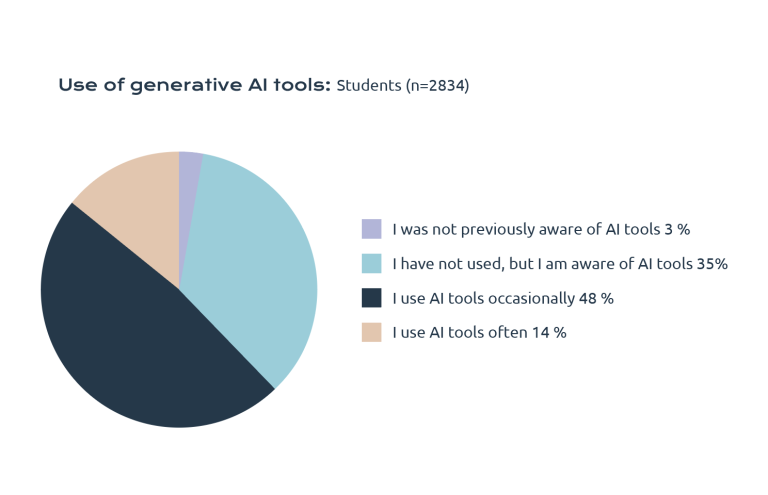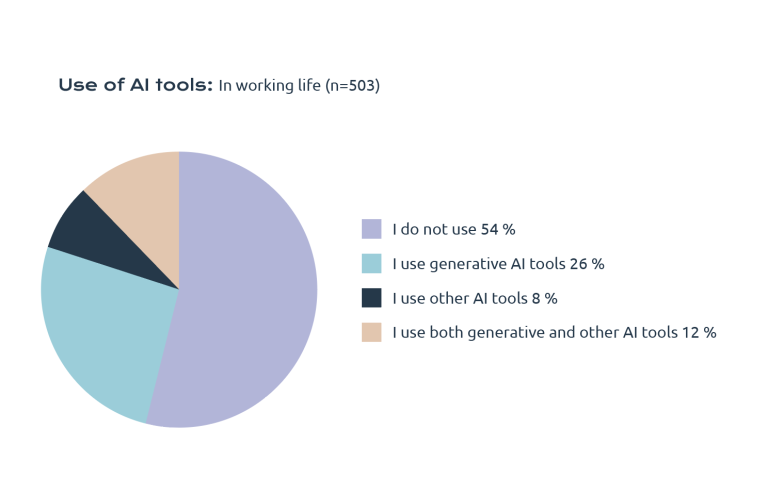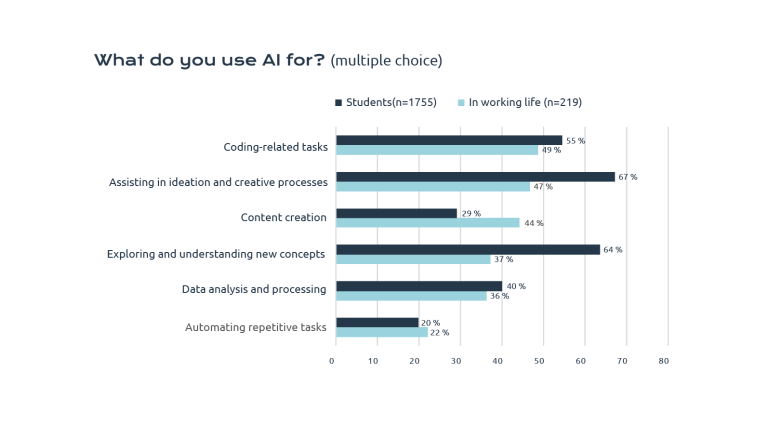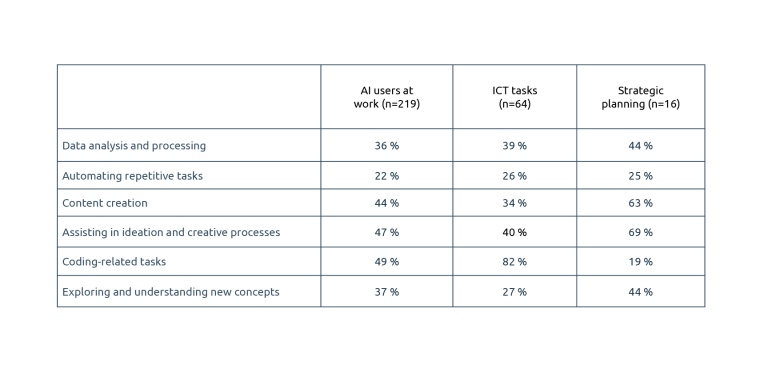
Generative artificial intelligence tools have risen rapidly to public discussion. ChatGPT was released in November 2022 and by January it had over 100 million users. ETLA estimated in the autumn of 2023 that about 20 percent of all work tasks can be replaced by current-type artificial intelligence systems. A significant part of the work tasks that can be replaced are remote work and creative work.
TEK’s members are at the forefront of technological breakthroughs. Tech professionals are needed to implement technology, and many adopt new tools on their own initiative. The use of artificial intelligence tools among TEK’s members tells about the change taking place in the whole society and also about the speed of the change.
TEK investigated the situation of working members with surveys carried out in cooperation with VTT Technical Research Centre of Finland in June and September. The use of artificial intelligence in studies was investigated in September as part of TEK’s annual Student Survey. This article examines the use of artificial intelligence in the light of the surveys conducted in the autumn of 2023 (more: Data and methods).
(The article continues below the images.)


AI tools are used in tech studies and work
Nearly two-thirds of tech students use generative AI tools in their studies (Figure 1). Less than half (48 %) use AI tools occasionally and 14 percent often. A good third of students report being aware of these tools, even though they have not used them. By field of education, computer science and ICT students stand out among the users of AI tools: one in five (20 %) of these students use these tools often and slightly more than half (52 %) occasionally.
Respondents in working life were asked about the use of AI tools in a slightly different way than students (Figure 2). However, the results suggest that generative AI tools have been adopted faster in studies than in working life. Of the respondents, more than half (54 %) report that they do not use any AI tools in their work. Generative AI tools are used by 26 percent of respondents, and in addition, 12 percent report using both generative and other AI tools.
(The article continues below the image.)

There are also clear differences between workplaces: in some, the use of AI tools is encouraged and supported, in others not. Of the working respondents, 36 percent agree with the statement “My company encourages the use of AI tools”, while every third (33 %) disagrees. Of the respondents, 38 percent disagree with the statement “My company has a policy on the use of AI tools”, while 36 percent agree. Furthermore, a quarter of respondents agree with the statement “My company provides training and guidance on the use of AI tools”, but more than half (51 %) disagree.
Among tech students, there is a lot of uncertainty about the use of artificial intelligence. For example: 18 percent of students agree with the statement “My university encourages the use of AI tools in studies”, 33 percent disagree, and 25 percent answer “I don’t know”. On the other hand, there is also uncertainty about whether the use of AI tools in studies is limited or even prohibited. Nor does there seem to be any training or guidance available, as only 8 percent of respondents agree with the statement “My university provides training and guidance to facilitate the use of AI tools”, 37 percent disagree, and 44 percent choose the option “I don’t know”.
AI is a general-purpose technology
In TEK’s previous machine learning study, it was estimated that AI is a general-purpose technology. A general-purpose technology can be identified by three factors: 1. it can be used in many fields, 2. it improves significantly when developed, which helps it spread to new sectors and 3. it creates new products and services and new ways of organizing work.
AI is already used for many purposes in tech jobs (Figure 3). The most common use (49 % of working respondents) was coding-related tasks. Next come assisting in ideation and creative processes (47 %) and content creation (44 %). Nearly a quarter of all respondents had used AI to automate repetitive tasks (22 %).
The use of AI varies depending on the work role. Amongst ICT workers the most common use was coding (82 %), seconded by ideation (40 %), while for example those doing strategic planning used AI more often for ideation (69 %) and content creation (63 %). The overrepresentation of ICT workers in the respondent group is reflected in the fact that the proportion of using AI for coding is large in the whole respondent group.
Students are ahead of working people in adopting AI tools in most use scenarios. Ideation and creative process assistance was used by 67 percent of students and new concept exploration and understanding by 64 percent.
(The article continues below the images.)


AI use requires learning
Respondents in working life consider AI to enhance work efficiency. A clear majority of respondents (76 %) agree with the statement “I believe that the use of AI tools will improve my efficiency”. Only 7 percent of respondents disagree with the statement. Respondents were also presented with a statement on whether the use of AI tools has led to longer working days. Most respondents (77 %) disagree, while 8 percent of working respondents agree.
Respondents were also asked “Have you spent time learning and experimenting with generative AI?”. A significant majority (89 %) of respondents have studied the use of AI independently or on a course provided by their employer. Learning to use AI is related to whether a person considers AI to enhance their work efficiency. Of those who had studied the use of AI, 78 percent considered AI to enhance their work efficiency, while of those who had not studied the use of AI, 57 percent considered AI to enhance their work efficiency.
Confidence in the continuation of one’s own employment
Respondents in working life are very confident about the continuation of their own employment despite the increasing use of AI tools (Figure 4). The vast majority of respondents (87 %) agree with the statement “I trust the continuation of my employment despite the increasing use of AI tools” and only 4 percent disagree. Half of the respondents (51 %) estimate that they have found it easy to adapt to the changes created by AI tools, although every fourth (27 %) does not know. Respondents were also presented with the statement “I am worried about how I will adapt to the changes caused by AI tools in my work.”. Most (71 %) respondents disagreed with this statement, while 10 percent agreed.
The need to update skills divides respondents: 39 percent estimate that skills need to be updated to ensure the continuation of employment, while 32 percent disagree (Figure 4). The view on skill updating is clearly related to the perception that AI tools will replace a significant part of one’s own work. Of those who consider skill updating necessary (=completely agree), nearly half (47 %) believe that a significant part of their own work will be replaced by AI tools within the next five years. On the other hand, of those respondents who think that skill updating is not necessary at all to secure the continuation of their employment, only 6 percent believe that a significant part of their own work will be replaced by AI tools.
Conclusion
The use of generative artificial intelligence has spread widely among both working and studying tech professionals during 2023. The actual transformation is only just beginning. Most of the students who responded to the survey said that their university’s policy on artificial intelligence tools is unclear or non-existent. The results are similar to those of professionals in working life. Artificial intelligence is a technology that is only at the beginning, and its development potential has not yet been seen. A significant part of the working respondents estimated that at least a third of their work tasks can be replaced by artificial intelligence within five years. The introduction of artificial intelligence will change work and job descriptions. It will require both people and organizations to be able to use new tools and adapt to changes.
Authors:
Mikko Särelä, Expert for industrial and innovation policy
Susanna Bairoh, Research manager
Data and methods
The use of artificial intelligence by TEK members in working life was investigated in cooperation with VTT with an anonymous web survey. A pilot survey was conducted in June (13.-29.6.2023), and 334 members participated. Based on the results, the survey was slightly modified, and the second round was conducted in the autumn (19.9.-7.10.2023). This survey received 503 responses, of which 418 were complete. In this article, these 503 members’ responses are used to describe the situation of working members. Both surveys were sent to 5000 randomly selected members, so the response rates were quite small (7 and 10) and the number of respondents using artificial intelligence in the September survey was about 200. This should be taken into account when looking at the results.
Compared to TEK’s working members in total, the respondents clearly overrepresent information processing or ICT workers as well as to some extent also research and development workers, university employees and those working in expert tasks, while for example project tasks or middle management are underrepresented. When viewed by age group and gender no biases can be detected. Generally speaking, the respondent group can be considered somewhat reliably representing TEK’s expert members in working life, but the above-mentioned biases are taken into account in the interpretation of the results.
TEK’s Student Survey is conducted annually in September as an identified web survey. The autumn 2023 survey (data collection 18.9.-1.10.2023) included questions on the use of artificial intelligence in studies. The target group consisted of all TEK student members (excluding freshmen, n = 19,788) and 2,908 people responded to the survey, so the response rate was 15. In the survey, women were significantly overrepresented compared to the target group, so the results reporting and analysis use gender-weighted results (n = 2834). Because the number of respondents is large and the weighted data represents TEK student members well, the results on the use of artificial intelligence by students can be considered reliable.
In the student survey, artificial intelligence was defined as follows: “Generative AI, a sub-area of artificial intelligence, uses machine learning to create new content, such as text, translations, code, images or music. For example OpenAI’s ChatGPT produces human-like text for various purposes and Midjourney produces images based on the written instructions given by the user. In this survey, artificial intelligence means generative artificial intelligence.” In the survey of working professionals, respondents were asked to take into account both general artificial intelligence and generative artificial intelligence applications at work, and in different questions it was specified whether all artificial intelligence applications or generative artificial intelligence are meant.
In this article, mostly descriptive analysis is used (frequencies and % distributions), which is supplemented by cross-tabulation.
More on the topic
Results from surveys of working professionals (VTT)
Results on tech students (in Finnish)
TEK’s report on the use of general technologies (pdf, in Finnish)